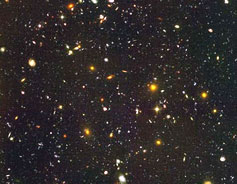

Tuesday - July 15, 2008
SLAC Today is available online at:
http://today.slac.stanford.edu
In this issue:
Dark Matter Burners
New Art Exhibit in the Research Office Building
Safety Today: Air Pollution's Effects
SLAC Library Re-Opens in Building 50
 |
 |
|
Tuesday - July 15, 2008 |

One of the reasons we can see so far across the universe could be the ionizing power of dark matter burning stars. (Hubble deep field image courtesy of NASA/ESA/S. Beckwith(STScI) and the HUDF Team.)
Dark Matter BurnersLike fishermen of the deep universe, population III stars cast their nets into a sea of dark matter and catch weakly interacting massive particles (WIMPS) to live on. Researchers at the Kavli Institute for Particle Astrophysics and Cosmology (KIPAC) at SLAC are exploring the life and evolution of these stars and have released their work in a paper that recently appeared on arXiv. The researchers found that these dark matter burning stars contributed to a great change in the universe in a different way than their non-dark matter burning relatives. Ancient population III stars may have captured dark matter and "burned" it as fuel. WIMPS—the prime particle candidates for dark matter—scatter off of the gas particles of a star, causing them to sink to the center, where they release energy. This energy can partly or completely replace the fusion that normally burns inside the star. The particles that the WIMPS scatter off of and the radius of the star create a cross section like the knots in a net: if the knots are too far apart, the dark matter particles will slip through. But a small enough cross section weaves a net that scoops up WIMPS to fuel the star for orders of magnitude longer than it would otherwise live. Read more... |
||
|
|
||
New Art Exhibit in the Research Office Building
Beginning today, visitors to the Research Office Building (ROB) will be surrounded by the photography of Peter Ginter. The German photographer's work will hang in the second-floor atrium area for the next three months. Read more... Air Pollution's EffectsA growing number of Americans are sniffling and suffering with allergies and asthma. Several studies have shown that air pollution and indoor allergens make asthma symptoms worse and can bring on an asthma attack. If you're one of the 23 million Americans who suffer from asthma, you might get some relief by taking steps to reduce indoor allergen levels and modifying your lifestyle to avoid the ill effects of air pollution. Asthma is caused by swelling and inflammation of your airways. When the airways narrow, less air gets through to your lungs, causing wheezing, coughing, chest tightness and trouble breathing. |
SLAC Library
|
SLAC Name Change
Events
Access (see all)
Announcements
|
| | ||
|
|
||
 <%
Response.AddHeader "Last-modified", getArticleDate()
'Response.AddHeader "Last-modified","Mon, 01 Sep 1997 01:03:33 GMT"
'Monday, December 06, 2010
%>
<%
Response.AddHeader "Last-modified", getArticleDate()
'Response.AddHeader "Last-modified","Mon, 01 Sep 1997 01:03:33 GMT"
'Monday, December 06, 2010
%>View online at http://today.slac.stanford.edu/ |
||